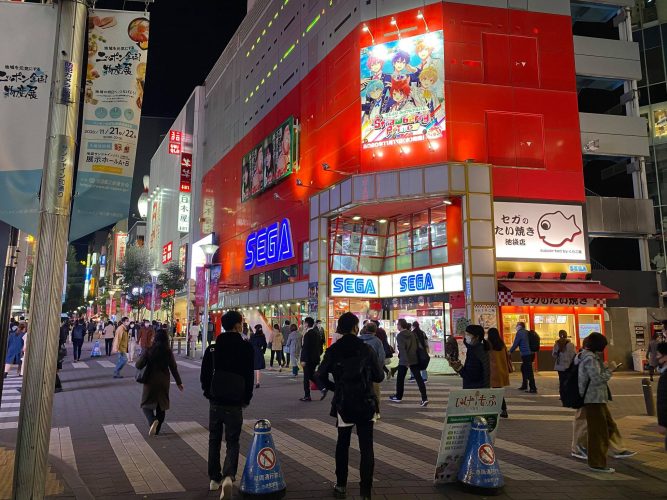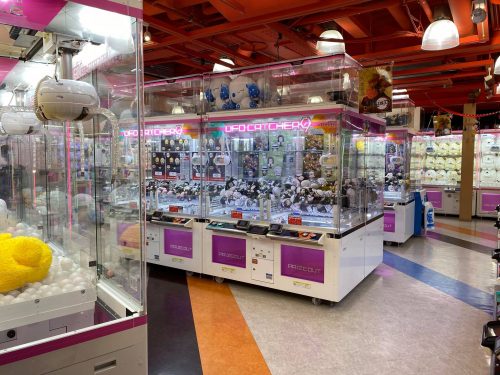
Most people, even non-otaku, know the brand name SEGA. Almost everyone can probably tell you that SEGA is somehow related to video games. For otaku and gamers, SEGA is so much more than just a brand name. It’s the company behind a legacy of video games, characters, and stories. Beyond the video games that SEGA has made over the years to enjoy in our homes, it’s also a huge arcade franchise across Japan. SEGA arcades have always been a staple part of an otaku’s travel itinerary in Japan, and for good reason. SEGA arcades are full of every kind of arcade game, including floors of crane games.
Now, though, the legacy of SEGA arcades in Japan is coming to an end. To honour the story of these game centres and what they have meant in Japan, we are going to take a look at their history, the culture around them, and what we are going to miss the most about being able to visit SEGA arcades. Spoiler alert! This is going to be a bittersweet article with a sad ending, so SEGA mega-fans, you’ve been warned!
A Bit of Background
SEGA has a long and interesting history in the arcade world that can be traced all the way back to the end of World War II. With an increase in American military presence in Japan after the war - and a ban on coin-operated slot machines in the US - a company called Service Games (named for its connection to the American Armed Services) was established in 1952 by a group of American men. Their goal was to provide slot machines as entertainment on military bases in Japan and across Asia. In 1954, the name SEGA showed up for the first time on the side of a slot machine, an abbreviation of Service Games. However, by 1960, the Japanese branch of Service Games had connections to the criminal underworld and was dissolved on May 31st of that year.
Thus, the SEGA we know and love was born from its ashes on June 3rd, 1960 when two companies called Nihon Goraku Bussan and Nihon Kikai Seizou bought all of Service Game’s assets in Japan. They began to manufacture slot machines, which they continued to do until 1965. Meanwhile, another American named David Rosen had begun a photo booth company in Tokyo named Rosen Enterprises. This company was purchased by Nihon Goraku Bussan in 1965, and the name changed to SEGA Enterprises, Ltd. That was when their focus switched from producing slot machines to military bases, and they began to instead import jukeboxes, pinball machines, and gun games into Japan.
These imported machines were all secondhand and broke a lot, so SEGA began to produce replacement parts for them instead of having to import those as well. It was just a matter of time before they began to make their own machines. By the end of the 1960s, SEGA had released its first arcade game, Periscope, to the world. It’s lights and sounds were innovative for the time and, driven by its international success, SEGA continued to produce and export more arcade games to America and Europe over the coming years. The 1970s saw a global arcade game boom, and SEGA was in a good position to benefit. They released the first eat-the-dots style game called Head-on (it would later become most famous in Namco’s Pac-Man), and then in the early 80s released Frogger and Zaxxon.
SEGA in Modern Japan

SEGA began to move into home gaming and software development from the 1980s onwards, which is how the company gained fame abroad. Nowadays, many gamers know SEGA as the name behind successful game series like Yakuza and Persona, which have also benefited from quality localisation (unlike one of SEGA’s most lucrative games series in Japan, Hatsune Miku’s Project Diva). But what about the game centres? Even as arcade culture began to fade outside of Japan, the industry remained strong inside its borders. While other companies like Taito and Namco also stepped up in the arcade business, SEGA remained a fore-runner for both owning game centres and producing new arcade games.
Game centres in Japan are beloved by people from all walks of life - all genders, ages, and nationalities can be found inside of them at any given time. SEGA arcades hosted crane machine games full of anime figures, plushies, and even snacks, along with photo booths, and plenty of music, fighting, shooting, and driving games. While there were plenty of games produced by SEGA like Project Diva available to play, SEGA arcades also had all the latest games from other companies, too. They were constantly updating with the latest titles, prizes, and capsule machines to keep people coming back for more.
Depending on where they were, some SEGA arcades were just a small part of a shopping mall, and others were behemoth structures many stories high that dominated the skyline. Some of the biggest SEGA arcades were in otaku hotspots like Akihabara and Ikebukuro with hundreds of different kinds of games inside. These game centres gave people a place to meet up with friends, blow off some steam, show off their moves, and take home exclusive prizes. They were a huge part of otaku culture in Japan - and even non-otaku people still used them now and again for fun. The flashing lights and distinct sounds of the machines created an environment unique to being in a game centre, and captured the hearts and imaginations of many people over the years.
The End of an Era

Flash-forward to 2020. Even though SEGA had been pulling in a lot of profits through their software and game centres, they were unable to escape the wrath of COVID-19. Sadly, SEGA has become yet another victim on the long list of companies affected by the global pandemic. Arcades are, after all, a haven for germs with their shared gaming consoles, closed spaces, and crowds. Understandably, they were closed in the first half of Japan under the country’s state of emergency, but even when arcades opened again people have been wary to return to them. By the end of 2020, SEGA had lost a lot of their profits. In September 2020, the most iconic SEGA arcade in Akihabara closed its doors for good. By the end of the year, SEGA’s other arcades across Japan will follow suit.
As sad as this news is, don’t forget though that SEGA is behind more than just game centres. While that may be a huge brand presence that they have in Japan, SEGA is still an international company that has a huge hand to play in the video game world. After all, they’ve been around 60 years so far and are still going strong, despite the closure of their arcades. SEGA has even been recognised by Guinness World Records for their contributions to the video game world, which includes more than 500 games and 70 franchises. While their arcades may be on the way out, hopefully we can still look forward to many more years of video games at home with SEGA!
And maybe the most positive bit of news? Even though SEGA won’t operate their own game centres any more, they will continue to produce games that can be played in other arcades.
Final Thoughts
One thing is for certain, SEGA arcades will definitely be missed by the otaku community. Whether you live in Japan or just visit, SEGA has always been a favourite stop and a familiar site in otaku neighbourhoods. SEGA arcades leave behind a lot of good memories for fans, though, and they will live on in the hearts of otaku around the world that had the chance to play games in them. SEGA arcades, you’re undoubtedly gone but not forgotten! Thanks for all the years of fun and we will still be enjoying your games from the comfort of our homes! And don’t forget there are still other game centres waiting for you across Japan, so all hope is not lost with the end of this particular chapter.
Did you ever have a chance to visit a SEGA arcade in Japan? Was it on your wish list? What other game centres are your favourites? Do you have any last words about SEGA you would like to get off your chest? Be sure to drop a comment before you leave!
]
Recommended Post


